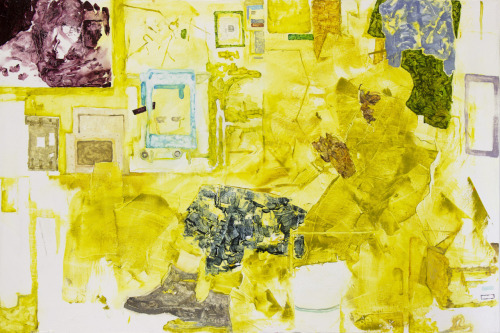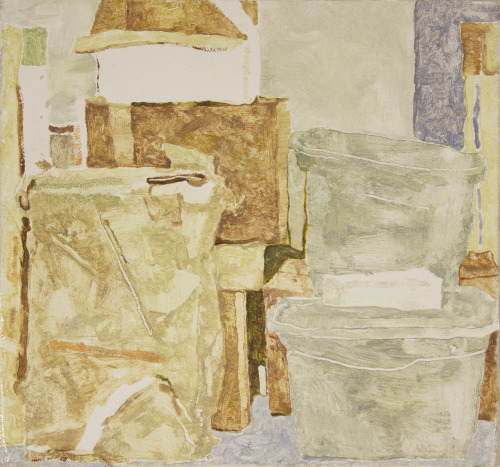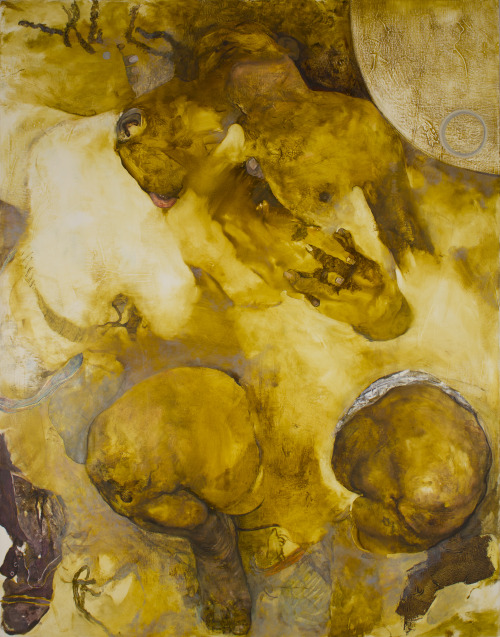
Packer looks for tenderness, for vulnerability, for intimacy. The viewer has to feel the human contact, the realness of the person. “My work is about love and generosity. It does not have anything to do with image making.” Her generosity towards her models may be big, but the space, the context, is very important too. There is no hierarchy. It’s about body and space together. Therefore many times they have the same color.
Rob Perrée analyzes the work of Jennifer Packer.
The recent paintings of Jennifer Packer.
TENDER AND VULNERABLE PORTRAITS
For many people portraiture is conservative, a genre from the past.
If you think about the commissioned portraits of royals, presidents and other ‘important’ people then indeed you must have the impression that portraiture is blind for the present. (1) There is no relation between maker and model, the artist uses a realistic style in order to make his model more impressive than he/she is in reality, he avoids experiments because he does not want to risk disappointing the commissioner.
If you think about portraiture as compared to the recent selfie-craze then, indeed, a painted portrait feels like a relic from ages ago. A selfie has more to do with fun, vanity, easy communication and playfulness. Quality is hardly involved, and the shelf life of one of these self-portraits isn’t more than a day or two. A selfie has a completely different function.
There are several contemporary artists, however, who have painted portraits that add new elements to the long history of traditional portraiture. I think about the work of Alice Neel. Her portraits are honest, they don’t hide anything, they lie somewhere between a sketch and a painting, they are moving and at the same time open for irony and humor. Marlene Dumas is another example. Her psychological portraits avoid reality. The person she paints is not recognizable as a physical being, it all has to do with the person’s context and emotion. Even the paintings of Kehinde Wiley challenge art history. They are realistic, they honor the model, put him/her on a pedestal. But at the same time they are tongue in cheek because of their exaggeration, their overstatement and because of their dominant, even screaming presence.
Within this evolution, he works of Jennifer Packer (1984) have their own personality. They follow the tradition and move it forward. Even her still lives are portraits.

Jo, 2014, courtesy the artist.
Jennifer Packer lives and works in New York, but was born in Philadelphia. She received her BFA there at the Tyler School of Art, Temple University. For her MFA she went to Yale. Yale was important for her in many ways. It gave her space to work in her studio without being disturbed. She did not allow people in her studio. Yale also made it possible for her to have many conversations about work and the working process. She learned to talk about her art, to express her ideas in words, and, if necessary, to defend them. Yale stimulated her to spend time studying her predecessors such as Velasquez, Picasso, Morandi, Philip Guston and many others, and encouraged her to gain a scholarly insight into art history. In 2005 she got the chance to go to Temple University’s Rome program to study. That stay had a big influence on her. The works of Caravaggio were an eye opener. His work motivated her. She recognized the underlying human intentions.
The first time that I saw the paintings of Packer they were in the group exhibition ‘Fore’ at the Studio Museum in Harlem in 2012. But a striking work of hers – ‘Ivan’ (2013) – reproduced in the 2014 spring edition of the magazine of that same museum made it impossible for me not to write about her work.
Jennifer Packer makes portraits and still lives. She asks friends and relatives to sit for her. There is no fixed plan. Sometimes she makes sketches, most of the time “it just happens”. The models are not posing, they are relaxed, confident. They are not sitting straight, they hang in the chair. Packer looks for tenderness, for vulnerability, for intimacy. The viewer has to feel the human contact, the realness of the person. “My work is about love and generosity. It does not have anything to do with image making.” Her generosity towards her models may be big, but the space, the context, is very important too. There is no hierarchy. It’s about body and space together. Therefore many times they have the same color.
Another important aspect of her work is mystery. She likes it when the viewer is uncertain of what he or she is seeing, what exactly is going on. A perfect example of that ‘procedure’ is ‘Lost in Translation’ from 2013. It takes a while to figure out where the person turns into the muddled environment.
Eric, 2014, courtesy the artist.
When she was asked to submit a work to the ongoing Romare Bearden project – a project to honor the importance and influence of Bearden organized by The Studio Museum – she referred to her being an African American: “In what manner do we, as brown bodies, position ourselves within our work and within the world? How do we acknowledge our accountability to our community?” These questions implicate that color might play a role in her work. The way she portrays her friends and relatives contradicts perhaps with the way they are seen outside or the way they have to act outside. In that sense her representation is perhaps in conflict, on purpose, with every day reality.

Untitled, 2013, courtesy the artist.
In ‘Structure’ from 2013 you can see that a still life by Packer has the same intimacy as a portrait. The two closets are worn out, the paint has fallen off. They are ready to be taken away by the garbage man, but the loving way she paints these ‘losers’ makes it impossible to be negative about them. The same can be said about ‘Untitled’ from 2013.
The notion of tenderness and intimacy has a lot to do with the way Packer paints. Because she puts on paint to take it off later, so it seems, there is a high degree of transparency in her work. She is not afraid of white spots. It suggests a careful way of working. There is also a lot of movement, liveliness, on the surface. Straight, masculine strokes are not there. She has an expressionistic way of using her brush. In one painting there can be a great diversity of touch. Although her color palette is limited – a lot of yellow, ocher and brown – she likes to use bright colors (red, green and blue) by way of contrast, as a way of focusing or desorienting the viewer.

Lost in Translation, 2014, courtesy the artist.
Jennifer Packer is very open to her intuition. “If I want to paint flowers I just do it.” She works in the moment. It is very well possible that will change a painting after a couple of years because the time seems right for that. She sometimes works on several paintings at the same time. This process makes it possible for one work to influence another work. It also makes mistakes more visible. “I am interested in mistakes. They have their own value.” She has the same openness toward the art history. She not only allows influences, she is never secretive about it. “Working in a library my pile of books could be seen by everybody while other students tried to hide the titles and the pictures. I am grateful to these artists, my predecessors.”
In planning her career she is more stringent. For a long time she did not allow people in her studio. For three years she worked completely isolated on her oeuvre. She is still selective in her professional appointments. She is careful in choosing her exhibition possibilities. “I would prefer a show where all my works can be seen. Drawings and paintings, flowers and portraits, great work and lesser work. I am not insecure about my work, I am just slow to get ready. I want to show in the right space.”
I am sure she is getting ready.
Note
- Recently a portrait of the new king of the Netherlands was commissioned. The result: a boring, Calvinistic, very traditional, detached portrait of a man who says he wants to be among his people……….The word ‘conservative’ fits here.
Rob Perrée is art historian, independent writer and curator, founder and editor in chief of Africanah.org. He lives and works in Amsterdam and Brooklyn.

